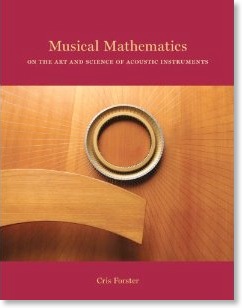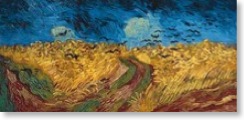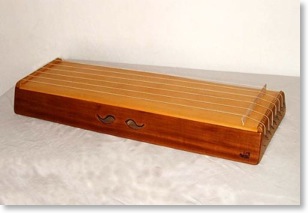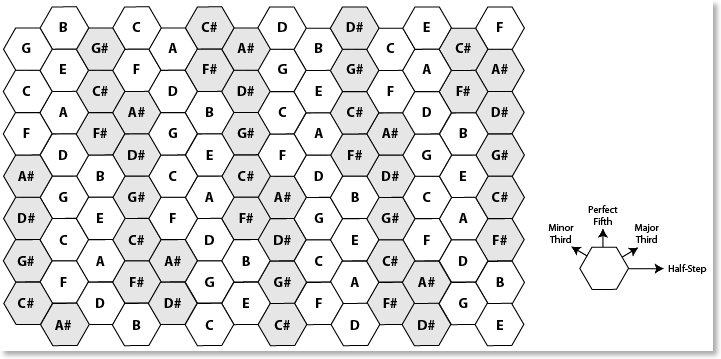A review of “Musical Mathematics” by Cris Forster
22 August 2010 Filed in: Music | Tuning
Theory

First, an anecdote: I was once in Amsterdam at the Van Gogh museum.
In front of Wheatfield with Crows the force of the painting was so strong that I had to turn away from it. I could feel the power of the painter and it was almost unbearable.


“Musical Mathematics” is a great work of art too but in order to appreciate Mr. Forster’s “power” the reader has to read at least a few hundred pages of this outstanding tome.
I can definitely feel it, recognize his encyclopedic knowledge and his dedication to the reader. Not only that, Mr. Forster too has been “seduced into carpentry”, like Harry Partch, and that means he is not only a very erudite man because his sources for writing “Musical Mathematics” were not only a myriad books but his own direct experimentations building instruments, measuring string length ratios, tuning pianos etc.
I am sorry to disappoint him but I am not going to build a “canon” after reading his book. Carpentry is not my thing.


He says: “Acoustic music is the most difficult music”. Probably that is why I am an electronic musician. I can easily retune my synthesizers (hardware and software) to any imaginable tuning system and those who follow my blog know my favorite one is Carlos Gamma (20th root of 3/2, a non-octave one), I can instantly convert ratios to cents and viceversa too.
Heidi Forster, his wife, says it took him ten years to write it and more years to prepare it for publication but this is obviously the work of a lifetime.
Something the reader can immediately sense is Mr. Forster’s care for him/her.
This is certainly not an elitist book. Mr. Forster really has done all he could to make possible the transfer of some of his vast knowledge to the reader.
The subject of this book is clearly not easy and the territory to cover is amazingly vast but Mr. Forster takes the reader through this journey making sure he/she does not get lost or discouraged. That does not mean reading/studying it is a simple task. There are chapters I am not going to read because 1) they are too difficult for me 2) I am not interested (I know it sounds like Aesop’s fable “The fox and the grapes” but that is the truth).


Mr. Forster knows that not all readers will go through his book from A to Z and for this reason suggests possible paths to follow.
My main path has been chapters 3,9,10 and 11 (see Table of Contents) but I started from the epilog written by his wife where she tells the story of her husband’s life. No doubts she too spent countless hours working on this book. My reverence to her for having supported this project for many years. I, then, jumped to chapter 3, parts of chapter 5 (because I am a keyboard player) then to chapter 9 to finally land to chapters 10 and 11 that were my real targets. These two chapters alone could be a massive book, almost 500 pages long, on the history of the tuning of musical instruments.
I, then, ended reading chapter 12 admiring Forster’s amazing musical instruments.
Saying that this book is the ultimate one on the subject of musical mathematics is an understatement. The level of details, of deep understanding, supported by Mr. Forster’s hands-on experimentations is almost unimaginable.
Mr. Forster is a composer, a musical instrument builder and an innovator. He is like one of those ancient scholars able to seamlessly move from one discipline to another surprising you at every step for their unmeasurable knowledge.
My praise to “Chronicle Books” for undertaking such a venture. The book has been printed on very nice paper and with a very good binding.
This is a book that needs to be read over and over again to really gain something from Mr. Forster’s work.
Someone could ask why an electronic musician like me should read this book considering that it deals exclusively with acoustic music. Paraphrasing Heidi Forster I could answer that “if we are to influence the course of musical history, the full history must first be learned”!
From my point of view I would like to add something about “the structural limitations of keyboard instruments” and “the physical limitations of the human hand” (section 10.30, page 349).
Modern technology makes possible the creation of so called isomorphic/generalized keyboards that can overcome both limitations mentioned by Mr. Forster but these are electronic keyboards so that is another story!

UPDATE:
Mr. Forster has published, among others, my review at this Chrysalis Foundation web page.
It is downloadable here (as a .pdf file).
X. J. S. commented:
This field of pitch and new instruments that we are privileged to explore unspoilt is so wondrous and vast. I genuinely feel for those musicians who have not yet stumbled into its beauty and power. But I know that all will eventually make the journey and discover the delights and sights of the full universe of music.


